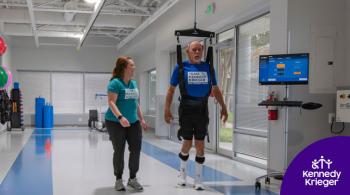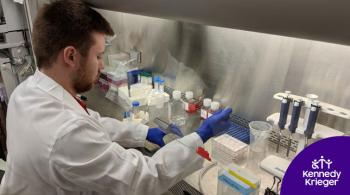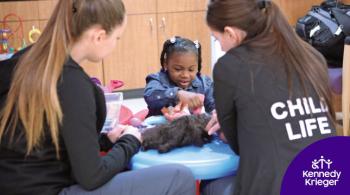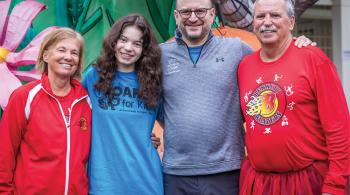
By Laura Thornton
As Doug drove his wife, Chrissy, and their newborn daughter home from the hospital, Chrissy Googled “facial birthmark” on her phone. Baby Quinnlyn had large port wine-colored birthmarks on her face, and they wanted to know why.
Doctors at the hospital had told Doug and Chrissy to have Quinnlyn’s eyes examined and to look out for anything unusual. That wasn’t reassuring…and neither was Google.
By Quinnlyn’s first appointment with her pediatrician a few days later, she had become very lethargic. The pediatrician referred her to a neurologist, who suspected Sturge-Weber syndrome, a neurovascular disorder in which abnormal blood vessels can cause seizures by age 2. Quinnlyn’s facial birthmarks were a sign of the disorder. MRI scans ordered by the neurologist when Quinnlyn was 7 weeks old confirmed the diagnosis.

The neurologist recommended two things right away: Quinnlyn should start taking a low, daily dose of aspirin, something he’d heard from colleagues might help. He also recommended Doug and Chrissy take Quinnlyn to see Dr. Anne Comi at Kennedy Krieger Institute, just an hour from their home in Pennsylvania.
At 3 months old, Quinnlyn had her first appointment with Dr. Comi, who directs the Institute’s Hunter Nelson Sturge-Weber Syndrome Center. Dr. Comi confirmed the diagnosis and the likelihood of seizures starting within a couple of years. She also confirmed that a low dose of aspirin, combined with anti-seizure medications, could help keep the seizures from starting. Doug and Chrissy began the treatments, and brought Quinnlyn to Baltimore every three months for check-ins with Dr. Comi.
“Dr. Comi helped us understand Quinnlyn’s diagnosis and how to care for her, and that, with the right treatment, she’d be okay,” Chrissy says.
A Groundbreaking Combination
Dr. Comi is quite likely the best person Chrissy and Doug could have found to treat their daughter. Sturge-Weber syndrome is her life’s work. About a decade ago, she and her research team discovered the gene that, when affected by a mutation, causes the disorder—a requisite discovery for developing treatment. Earlier this year, she co-published the results of a study she led with researchers at Boston Children’s Hospital confirming that young children with Sturge-Weber syndrome who start taking aspirin and anti-seizure medications while they’re still seizure-free were about 40% less likely to develop seizures at a young age. The study was based on years of observations of patients.
“The aspirin was initially proposed decades ago,” Dr. Comi explains. “I was using it for treatment once seizures began, so it made sense to try using it presymptomatically. That alone didn’t appear to make a difference, so I combined it with an anti-seizure medication.”
It was a groundbreaking combination: With this treatment, many children born with Sturge-Weber syndrome never develop seizures at all. Quinnlyn, now 8, is one of them.
We’re so thankful for Kennedy Krieger and Dr. Comi.” – Quinnlyn’s dad
Possibilities and Opportunities
At first, Chrissy and Doug counted the weeks, then months, that went by without a seizure. “We made it six months, then a year, and every month, we recognize how far we’ve come,” Doug says. Now, they’re allowing themselves to imagine the very real possibilities and opportunities for their daughter.
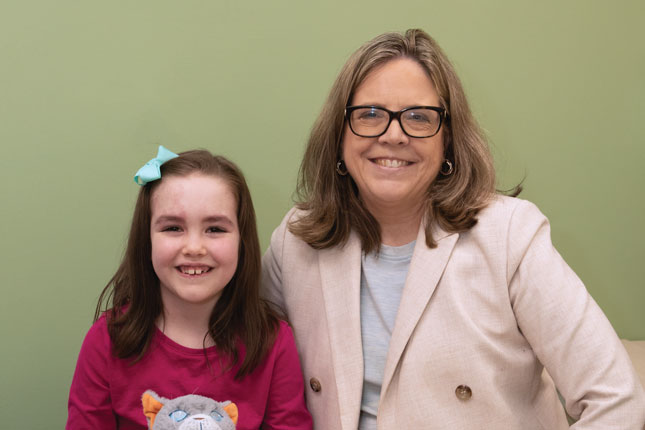
Quinnlyn meets with pediatric neurologist and researcher Dr. Anne Comi, director of Kennedy Krieger’s Hunter Nelson Sturge-Weber Syndrome Center. Dr. Comi has guided Quinnlyn’s care for Sturge-Weber syndrome since Quinnlyn was a baby.
“I hope she gets to live a long, happy life and do everything she dreams of, and continue to achieve what had seemed so unachievable when we first learned of her diagnosis,” Chrissy says.
Quinnlyn wants to be a veterinarian when she grows up, but in the meantime, she enjoys softball, theater, piano, and composing and performing songs with her band, the Rainbow Rockers. She also does physical therapy to maintain her strength. To children everywhere navigating a tricky diagnosis, Quinnlyn advises, “Be brave.”
Doug credits Quinnlyn’s good health to Dr. Comi, as well as to his daughter. “She’s always been so internally driven to move forward and conquer the day’s challenge,” he says. “She has this internal drive to always push past the limitations, and we hope that never changes.”










